
* While the facts in the case of the Kennedy assassination were disputed for decades, there was really never much ambiguity to them. Lee Harvey Oswald was a calamity waiting for a place to happen; when the opportunity arose, the calamity happened, leaving three people dead in the end. The sequence of events was as straightforward and chaotic as a fall down a flight of stairs.
* People have long been fond of conspiracy tales, imagining that various ills of the world are due to a secret plot of an evil cabal -- the most classic example in Western culture being antisemitism, with the most famous manifestation being a tract titled THE PROTOCOLS OF THE ELDERS OF ZION, originally published in Russia in 1903 and detailing the plot for domination by the "Elders of Zion".
Conspiracy tales being universal, of course they were common in the United States from the beginning of the Republic. Antisemitism was popular, but from the 18th century there was also considerable suspicion of Freemasons, even though many of the Founding Fathers -- George Washington, Benjamin Franklin, and James Monroe -- were Masons. The Masons tended to invite suspicion from their secretiveness and quirky rituals.
Anti-slavery agitation in the period up to the US Civil War led to the rise of conspiracy stories in the South, primarily concerning efforts to provoke slave uprisings. These conspiracy tales were given some weight by the intemperate rhetoric of anti-slavery activists -- even though such activists were more noisy than effective, and they had negligible support in the Federal government. Nonetheless, as the push towards secession grew, the Federal government was increasingly seen as sympathetic to abolitionists, or even under their control. The more evident reality was that the Federal government attempted to accommodate the South, but Southerners weren't impressed. Paranoia led to secession, rebellion, defeat, and ruin.
After World War I, the USA became isolationist, with the story emerging that America entered the war only because of the manipulations of arms manufacturers and bankers; the Kaiser's submarines torpedoing American ships, it seems, had nothing to do with it. In the 1930s, in the face of actions of what would be called the "Axis powers" -- authoritarian and imperialistic states including Adolf Hitler's Nazi Germany, Benito Mussolini's Fascist Italy, and Imperial Japan -- Congress passed a series of "Neutrality Acts" to ensure that the administration of President Franklin Delano Roosevelt (FDR) toed the isolationist line.
FDR did so, but simultaneously raised concerns over the actions of the Axis Powers in Europe and the Far East. While Europe was more important to the USA, Japan was a more direct irritant, particularly after Japan invaded China in 1937. America condemned the invasion and gradually began to impose sanctions on Japan.
With the coming of war in 1939, America redoubled its preparations for a fight, and from 1940 began to ramp up sanctions on Japan. Isolationists did not like the idea of going to war, and formed an "America First Committee" to ensure continued isolation. However, the drift towards war couldn't be stopped. By late 1941, US sanctions were threatening to economically cripple Japan, with America also building up a navy that Japan would not be able to match. The Japanese decided to perform a pre-emptive attack on the USA that would be so devastating that the isolationist and pacifistic Americans would not be able to oppose Japan further.
Preparations were made in complete secrecy, with a Japanese fleet built around six aircraft carriers making its way across the Pacific to Hawaii. On the morning of 7 December 1941, hundreds of Japanese aircraft descended on the US Navy anchorage at Pearl Harbor in Oahu. When they were done, four battleships had been sunk, four others damaged, with many lesser vessels damaged and over 2,400 Americans dead.
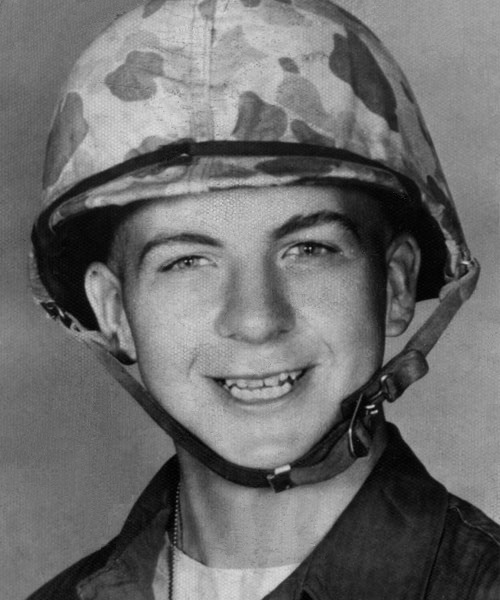
The raid on Pearl Harbor proved to be a huge mistake for Japan. The Japanese injured but did not disable the US Navy, with the attack enraging Americans to take vengeance on Japan. It took almost four years of fighting, but Japan was forced to surrender after two atomic bombs were dropped on Japan in August 1945 -- the first, and so far the last, time nuclear weapons were used in combat.
* Even as cleanup followed the raid on Pearl Harbor, there were loud protests over the way America had been taken by surprise; somebody needed to be blamed. An investigation into the actions of the commanders on the spot, Navy Admiral Husband E. Kimmel and Army General Walter C. Short, found them derelict of duty and relieved them of command. They soon retired from the military.
There would long be protests that Kimmel and Short were unfairly treated, but they had received a war warning. It wasn't specific; all anyone knew was that Japan was preparing to take the offensive -- and the long-range use of carrier air power by Japan was unprecedented, many hardly believing the Japanese, generally regarded by Americans of the time as inferior, could have done it. In any case, the military necessarily takes a dim view of failure; commanders who lose battles are inevitably dismissed or worse. Kimmel and Short were merely dismissed.
More significantly, a conspiracy story was devised to hold the FDR Administration responsible for the attack. In large part, the stories were driven by isolationists to shift the blame for the lack of preparedness for the attack on Pearl Harbor. There were variations on the conspiracy story -- but in essence, it said that FDR deliberately provoked Japan into attacking the USA so he could drag America into the war; that Japanese naval codes had been cracked, and FDR knew the attack was coming; and he refused to give field commanders adequate warning.
Nothing in this story ever held up under investigation: nobody thought the "weakling" Japanese would dare attack the USA, Japanese naval codes weren't cracked until well into 1942, and a nonspecific war warning was in fact issued. No official document trail has shown that anyone in the US government knew about or expected the attack on Pearl Harbor before it happened. There was also arguable logic to the conspiracy story: if FDR knew the attack was coming, wouldn't it have made more sense to prepare an ambush that would hinder or even cripple Japan's war machine? America would have gone to war on a much stronger basis.
* In the postwar period, with Germany and Japan defeated, America's worries increasingly focused on the Soviet Union. There had been a streak of anti-communism in the USA since the foundation of the USSR, but following the war, it did appear as if communism was out to conquer the world. The fears were given some basis in fact when a number of traitors working for the Soviets were uncovered.
That led to a wave of paranoia against communists in the USA, with Senator Joseph R. McCarthy -- a Republican from Wisconsin -- at the lead. In 1950, he publicly announced that he had a list of 205 communists in the State Department, with McCarthy adding new accusations later. He could prove nothing, but he did succeed in provoking extreme harassment of Leftists in the USA. McCarthy finally overreached himself in 1954, when he turned his sights onto the US Army. In Congressional hearings, which were ground-breakingly televised, McCarthy was publicly discredited, and then would be censured by the Senate. He lingered as a political nonperson until his death three years later.
Even after McCarthy sank from public sight, public hysteria remained at a high level -- manifested most peculiarly by excitement over "unidentified flying objects (UFO)", strange lights in the sky that the exciteable took for alien visitors. The core legend of UFO lore arose in 1947, when a rancher near Roswell, New Mexico, found strange debris of some flying object on his land. The military picked up the debris and put a lid of secrecy over the incident.
As it turned out, the secrecy was to cover up Project MOGUL, which was an effort to acoustically detect the sound of a nuclear blast -- and other acoustic phenomena -- with microphones carried on a balloon. Tales went around that the MOGUL debris featured "strange alien hieroglyphics". As it eventually turned out, the MOGUL balloon carried kitelike low-tech radar reflectors that had been built on contract by a toy company. The toy company used materials at hand to build the reflectors, including plastic tape marked with pink & purple flowers, along with geometric designs. From a modest start, UFO stories would become a persistent and endlessly mutating conspiracy theme.
More ominously, extreme-Right groups emerged in the postwar period, most notably the John Birch Society -- John Birch having been a US military intelligence officer, once a Baptist missionary, killed by Chinese communists in 1945. The John Birch Society was founded by wealthy Rightists, and followed a strong anti-communist line, warning of the communist conspiracy for world domination, while finding communists in the government and other organizations. They also angrily pushed back on America's efforts to end segregation, invariably accusing civil-rights activists of being communists. Actually some were, such as actor Paul Robeson -- but not all were. Communism was on the wane in the USA at the time anyway, in part because of widespread harassment of communists, in part because of disillusionment of with communist regimes.
It should be noted that the John Birch Society also believed that fluoridation of water supplies -- trace amounts of fluoride having been introduced into the water supply in the postwar period to reduce tooth decay. There was no evidence that fluoridization was hazardous to health, but the John Birchers and the like believed it to be a menace to America.
It was in this paranoid Cold War environment that John F. Kennedy (JFK) was elected President of the United States in 1960. That would lead to the biggest conspiracy story in American history, centered on a misfit named Lee Harvey Oswald.
BACK_TO_TOP* Lee Harvey Oswald was born in New Orleans, Louisiana, on 18 October 1939. His mother was Marguerite Oswald, his father was Robert E. Lee Oswald, who had been Marguerite Oswald's second husband and had died two months before the birth. Marguerite had two other sons, Robert Oswald and John Pic, Pic being the son of Marguerite's first husband. It was not much of a happy family, Robert and John later having little good to say about their mother, describing her as unbalanced and mean-spirited.
Lee had an unsettled childhood, having no father to provide much guidance, and being moved around a good deal. In the summer of 1952, Marguerite took Lee to New York City. He bounced from one school to another, often absent from classes; his truancy led the authorities to look into the boy's case. He was examined by a psychiatrist, who found the boy angry, withdrawn, antisocial. Revealingly, Lee told a psychiatrist: "I don't want a friend and I don't talk to people." When asked if he preferred the company of boys or girls, he replied: "I dislike everybody."
Case workers recognized that Marguerite seemed to be a big part of Lee's problems, the mother being both overly indulgent and overly controlling, and so getting him out of her custody seemed like a good idea -- to the authorities at least. Of course Marguerite didn't like it, and at the beginning of 1954, she took Lee back to New Orleans. The authorities in New York City had no jurisdiction out of state, and Lee basically dropped off their radar screen.
Those who knew Lee after he came back to New Orleans found him standoffish, insolent, and inclined to get into fights. For whatever reason, he started reading about communism and was taken with the idea, though he never really investigated the subject in depth and never joined the communist party. Robert Oswald later suggested that Lee got into communism just to be rebellious -- he was, in modern usage, trolling. Otherwise, Lee didn't seem to have much in the way of interests. He finally dropped out of school to worked at menial jobs.
Lee looked up to Robert, who had been a Marine, and so Lee wanted to be a Marine as well. When Lee turned 17 in October 1956, he promptly signed up with the USMC. He was trained as a radar operator and ended up in an air traffic control station at the air base at Atsugi, Japan. The supersecret U-2 spy plane flew out of Atsugi, and some conspiracy paranoids suggest Oswald had a spy connection to the U-2 program, but he had no clearance into the program; all he did at most was watch U-2s come and go.
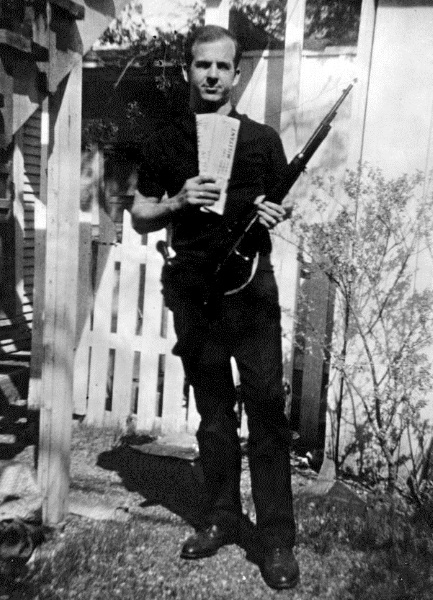
Oswald gradually became a disciplinary problem. After he got drunk and tried to pick a fight with an NCO, he was thrown in the brig, an experience that embittered him. After he got out of the brig he rotated back to the States, serving at the Marine base at El Toro, California. By that time he was making little attempt to conceal his communist sympathies, with some of the other Marines calling him "Oswaldovich". Oswald managed to swing a "dependency discharge" to care for his "disabled" mother -- Marguerite had indeed hurt herself, but not severely; she had talked a doctor into declaring her disabled so she could get payments. He got out of the Marines in late September 1959, and promptly took a freighter to Europe. His ultimate destination was Moscow, where he arrived on 16 October.
On arrival in the USSR, Oswald asked for Soviet citizenship. He wasn't wanted. The Soviets had plenty of experience with nobodies like Oswald, and had found them far more trouble than they were worth. Oswald was debriefed by the KGB, the Soviet intelligence service -- but as one official later said: "There were conversations, but this was such outdated information, the kind we say the sparrows had already chirped to the entire world, and now Oswald tells us about it."
The KGB saw no value in him and thought him unstable. The Soviets turned down his request for citizenship; he slashed his wrist and had to be rushed to the hospital for blood transfusions. After the suicide attempt, the KGB was even more certain they didn't want Oswald, but they were also not sure of what to do with him. The US and the USSR were in one of their periods of trying to get along, and the authorities didn't want to mistreat their American guest. Oswald was granted a temporary right to stay and sent to the city of Minsk, where he was kept under passive surveillance by the KGB. Any active interaction with him by KGB personnel was strictly forbidden.
Oswald got a job in a factory and, with the help of a stipend provided by the government, it seems as a reward for defecting, was making good money by Soviet standards. However, life in the USSR didn't match the fantasy he had put together in his head of a classless utopia, and by the end of 1960 he had become disillusioned. By early 1961, he was writing the US embassy for help in returning to the USA. His efforts to go home were complicated by the fact that he then married a Russian girl named Marina Prusakova. Soviet authorities would have been happy to see him go, but they weren't keen on letting a Soviet citizen go with him. Oswald persisted and managed to finally leave the country in June 1962. By this time the couple had a baby, a girl named June.
* All but penniless, Oswald and his little family ended up living in the house of his brother Robert in Fort Worth, Texas. The FBI interviewed Lee, to find him contemptuous and uncooperative. The FBI would check up on him every now and then, though the bureau didn't think he represented a threat; he had no criminal history, and he wasn't in any position to be a useful spy. Spy? Spy on what? However, Oswald would increasingly see the FBI as persecuting him.
Oswald got a job with the Leslie Welding Company in July and moved his family to a seedy rental house. He stayed at Leslie until October, when he decided to change jobs, finding work at the Jaggars-Chiles-Stovall Company, a Dallas graphics-arts firm, working in photoprinting. He relocated his family to Dallas in November. By that time, he was becoming abusive to Marina, beating her on occasion. She put up with it because she had nowhere else to go, and in fact Lee used the threat to send her back to the USSR to keep her in line.
In February, the Oswalds ran into a couple named Michael and Ruth Paine at a dinner party. The Paines were both American Civil Liberties Union (ACLU) members, liberal activists in conservative Texas. Ruth, a Quaker, was trying to learn Russian and took a sympathetic interest in Marina Oswald. The Paines would get to know the Oswalds about as well as anyone ever did.
* Although Oswald didn't have much money to spare, he did decide to buy a 0.38-caliber Smith & Wesson revolver and an Italian war surplus 6.5-millimeter Carcano rifle through the mails. The weapons were purchased in the name of "A. Hidell"; Oswald used the facilities at Jaggers to create fake ID for "Alek Hidell" to allow him to pick up the weapons when they arrived, by coincidence together, on 24 March. On 31 March, he had Marina take pictures of him in the back yard wielding the Carcano rifle, with the revolver stuck into his belt. He developed them himself and wrote "For Junie from Papa" on the back of one. Marina was baffled as to why Junie would want such a photo, and he told her: "To remember Papa by sometime." One of the photos was later discovered inscribed with: "Hunter of Fascists, Ha, Ha, Ha", it seems by Marina. Conspiracy paranoids assert the "Fascist Hunter" photos are fakes, but professional examination showed them to be for real.
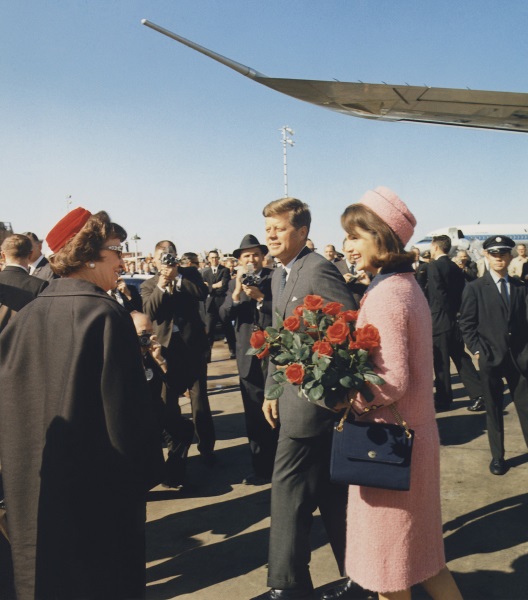
Jaggars didn't like Oswald's work habits and poor people skills, so they fired him on 1 April. He didn't tell Marina right away. Out of work, he spent part of his time scoping out the home of Edwin Walker, a retired US Army General and prominent local Rightist. On Wednesday, 10 April, Lee told Marina he had been fired. He went out after dinner, with Marina then finding a list of instructions written by Lee in Russian for her, telling her the bills had been paid up, he'd left her a bit of money, and concluding by telling her that "if I am alive and taken prisoner" where she could find the jail. Marina started shaking; by the time Lee came back, she was frantic.
While Lee was out, somebody had taken a shot at Walker while he was working on his income taxes in his dining room. Walker barely missed getting a bullet in his head by a freak of luck; the bullet hit the wood framing in the middle of the window, which deflected it. As Walker himself explained later, the light in the room coming out would have flooded around the narrow strip of framing, rendering it invisible in the scope of the rifle. Lee had come home in a state of excitement and told Marina that he'd tried to kill Walker, saying: "I missed." Marina concluded Lee was deranged, but was fearful of going to the authorities lest she be considered an accomplice.
* Unemployed, Lee Harvey Oswald had to determine what to do next. He decided to move back to New Orleans -- Marina later said she encouraged the move, thinking that if he stayed in Dallas he might try to kill Walker again. Oswald left for New Orleans on a bus on Wednesday, 24 April 1963, with Marina and baby June staying behind with the Paines at their house in the Dallas suburb of Irving for the moment. He found a job on 9 May with the Reily Coffee Company, maintaining the machinery. He got himself an apartment and had his family join him. In New Orleans, Oswald became increasingly obsessed with Fidel Castro and the communist Cuban state. Oswald got in touch with a national organization named "Fair Play For Cuba", and decided to open up a New Orleans chapter; he was the only member.
Oswald's work habits at Reily weren't any better than they had been at Jaggers -- he was fond of pointing a finger at people and saying: "Pow!" -- and he was fired on 19 July. To collect unemployment benefits he had to report to the Louisiana Employment Commission the job applications he had made, and he mostly just fabricated them; by that time, he routinely lied about everything.
With no job, Oswald focused on his Fair Play For Cuba activities, while simultaneously trying to "infiltrate" an anti-Castro Cuban group, claiming he could train them in guerrilla operations. Oswald was apparently playing James Bond; the Cubans were unsurprisingly suspicious of him, and when they spotted on 9 August him handing out Fair Play for Cuba flyers on the street, there was a confrontation, with the police arresting both Oswald and the Cubans. The Cubans were released, Oswald had to pay a $10 USD fine. He persisted in his solitary efforts for Fair Play for Cuba, even getting a little publicity on a radio talk show -- which backfired when the lies he told in interviews caught up with him, the publicity just making him out a fool and a fraud.
After the public humiliation Oswald dropped his political activism, such as it was, with Marina finding his behavior increasingly erratic. He started playing a lot more with his rifle; Marina asked him why, and he replied, to her shock, he was thinking of hijacking an airliner to Cuba. Marina finally managed to convince Lee that he might come up with a less drastic way of getting to Cuba. He decided to go to Mexico and visit the Cuban embassy in hopes of being allowed entry to Cuba. Ruth Paine was to take Marina and June back to Dallas; Paine showed up with her kids on 20 September, and left on Monday, 23 September, with Marina and June to stay at the Paine's house. On her departure, Marina wasn't sure she'd ever see Lee again.
* Oswald left New Orleans on 25 September, arriving in Mexico City on a bus on 27 September, a Friday. He went to the Cuban embassy that day and tried to get a visa; the embassy staff wasn't inclined to give him one, suggesting that it would help if he got a Soviet visa first, sending him over to the Soviet embassy. They didn't know what to make of him there and told him to come back on Saturday. After he left, the embassy staff wired Moscow about Oswald, and got back a reply telling them to politely get rid of him. When Oswald came back on Saturday, they blew him off, and he threw a raving fit. After he left, the embassy staff judged him "psychotic". Oswald went back to the Cuban embassy and they blew him off too, resulting in another fit.
Oswald bummed around in Mexico City for a few days, finally leaving on Wednesday, 2 October. The US Central Intelligence Agency (CIA) had a presence in Mexico City and was keeping an eye on the embassies; they did take note of Oswald's visits to them, but botched everything, sending in a report about a "Lee Henry Oswald", and obtaining a photograph of the wrong person. Conspiracy paranoids would read everything into the discrepancies except incompetence.
Oswald returned to Dallas to look for work. Marina remained with Ruth Paine, while he found lodging in a boardinghouse. In mid-October, Ruth was talking to some neighbors about Oswald's search for work. One, Linnie Mae Randall, said that her brother, Wesley Buell Frazier, had got a job downtown at the Texas School Book Depository (TSBD), a privately-operated textbook distribution center, and that the TSBD needed temporary help. Oswald went to the TSBD on 15 October, speaking to a supervisor named Roy Truly; Oswald made a good impression, and Truly hired him. Frazier was living at his sister's house near the Paine residence at the time, and on learning that Oswald visited his wife there on weekends, offered to give him a lift if he needed it.
Marina gave birth to a second child on 20 October, the baby girl being named Audrey. Oswald seemed to have mellowed on his return to Dallas from Mexico, but it was only temporary; after the birth of Audrey he began to revert to form, pushing Marina around and acting surly.
BACK_TO_TOP* President John F. Kennedy had decided to perform what amounted to a campaign tour of Texas in a meeting with Vice-President Lyndon Baines Johnson (LBJ), a Texan, and Texas Governor John Connally on 5 June 1963. The president was to make appearances in five Texan cities, in the order of San Antonio, Houston, Fort Worth, Dallas, and Austin. JFK's visit to Dallas was planned for 22 November 1963. The president and his entourage were to fly into Love Field in Dallas in the morning, with a motorcade to travel from the airport to the Dallas Trade Mart, where he would give a speech. The motorcade would pass through Dealey Plaza, a public square on which the Texas Book Depository bordered. The route of the motorcade was described in the Dallas papers on 19 November 1963, and a map of the route published to allow the public to observe the visit.
Oswald liked to read the papers, making a point of going through them each morning in the lunchroom on the first floor of the depository. He couldn't have missed the front-page articles from 19 November that showed the motorcade route went down Elm Street, right in front of the TSBD. On Thursday, 21 November, he asked Frazier for a lift to Irving. It was the first time he went to the Paine house on a weekday. Frazier dropped him off at the Paines' house that evening. Lee ate dinner with Marina and the Paines, acting very taciturn; Marina brought up the presidential visit to Dallas, but he wouldn't comment. She found that odd, and asked if he knew about the route of the president's motorcade. He replied he knew nothing about it.
Lee got up and left early the next morning. When Marina got up, she was startled to find that he had left her $170 USD on top of the bedroom bureau, which was almost all the money he had in the world. She didn't notice until later that he had also left his wedding ring in a cup on the bureau; she'd never seen him take it off before. That same morning -- Friday, 22 November 1963 -- Oswald picked up his ride from Frazier, with Oswald carrying a long item in an improvised paper bag. Frazier asked Oswald what was in the bag, and he replied: "Those are curtain rods."
When they got to the depository, Oswald seemed to be in a hurry to get inside with the package. Few saw Oswald around that morning. Towards midday, TSBD employees went to lunch and then formed up in small groups to observe the presidential motorcade, which was to go by sometime after noon. Oswald was seen on the sixth floor of the TSBD by workers when they broke for lunch, but nobody saw him again before the motorcade came by.
* JFK and his entourage had flown into Love Field as scheduled on the morning of 22 November. While it had been raining that morning, the weather soon turned sunny for the motorcade through Dallas. The president, Governor Connally, and their wives rode in an open-top 1961 Lincoln Continental limousine. The people of Dallas came out in numbers to cheer the president, damping worries that JFK would get a hostile reception. Kennedy even had the limousine stopped twice so he could get personal with citizens.
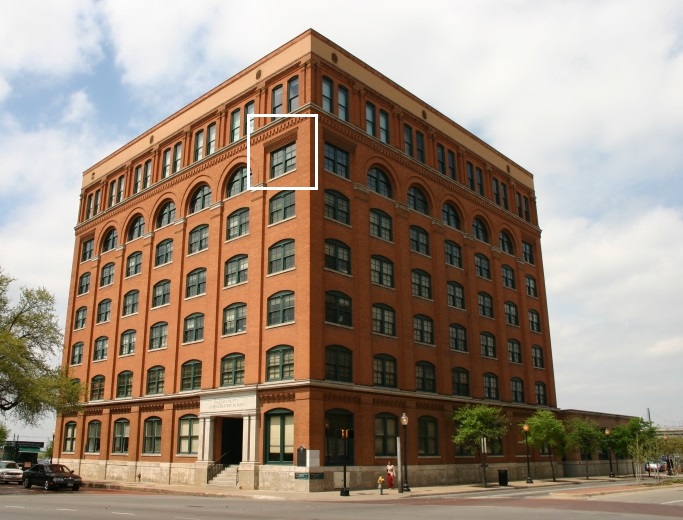
People were lining Elm Street when the motorcade arrived at 12:30. A garment manufacturer named Abraham Zapruder was standing on top of a wall, filming the motorcade with an 8-millimeter home movie camera as the president's limousine turned onto Elm; his 26.6-second film would prove to the most famous amateur movie in history. The crowd was enthusiastic, and Mrs. Connally turned to tell JFK: "Mr. President, you can't say that Dallas doesn't love you."
Kennedy replied something to the effect of: "No, you certainly can't."
Those were his final recorded words. After the limo completed the turn on to Elm Street, a shot rang out. Connally was a hunter and immediately judged the sound to be a rifle shot. He turned around to his right to see where the shot had come from, then started to turn back to his left to look at JFK and Jackie.
Three witnesses on the sidewalks saw a rifle sticking out of the northeast corner window on the sixth floor of the TSBD. One of the witnesses, a steamfitter named Howard Brennan, got a look at the shooter as well. The shooter fired again; the president's arms then jerked up to his neck level while Connally, hit, fell over onto his wife, saying: "Oh no, no, no!" The governor saw blood on his shirt and cried out: "My God, they're going to kill us all!"
A third shot then rang out and the right side of the president's head exploded in an ugly splash of blood and brain tissue. The driver of the limousine, Secret Service Agent Bill Greer, had slowed down after the second shot; now he hit the gas, with the limousine and its injured passengers speeding off to Parkland Hospital in Dallas.
On the northeast corner of the fifth floor of the TSBD, three employees of the depository had been watching the motorcade when the shooting started. They heard the shots coming from the sixth floor directly above them, with one, Harold Norman, later saying: "When the first shot came, I heard BOOM, then klik-klik BOOM, klik-klik BOOM." They could hear the tinkle of cartridge cases hitting the floor after each shot.
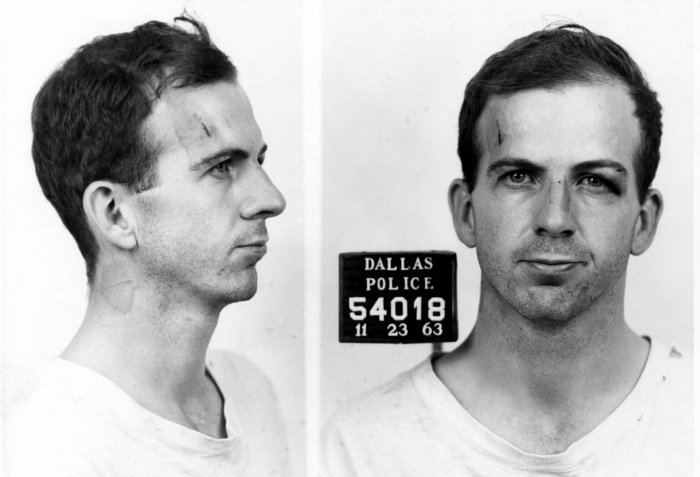
* A Dallas policeman named Marrion Baker who was in the motorcade saw pigeons flying off the roof of the TSBD. He pulled over his motorcycle and dashed inside, linking up with Roy Truly to get upstairs. They ran into Oswald on the second floor, but Truly vouched for him, and so the two men went on upstairs. Oswald left the TSBD immediately, taking a bus and then, when traffic jammed up on him, getting off and taking a taxi to near his boardinghouse. There, at a little before 1:00 PM the housekeeper, Earlene Roberts, saw him go to his room in a hurry, then leave again with a jacket on.
Howard Brennan had given his rough description of the shooter in the TSBD to the police, who had sent out an all points bulletin to patrol cars. At about 1:15 PM, Officer Jaydee Tippit -- he wrote his first name as "JD", but they weren't initials, that was his name, pronounced "jaydee" -- spotted a pedestrian matching the description of the shooter and pulled up his patrol car. It was Oswald; when Tippit got out, Oswald shot the policeman four times, killing him. Witnesses observed the shooting or Oswald fleeing the scene of the crime with a pistol in his hand.
Police cars, sirens blaring, ran up and down the streets. Oswald ducked into a shoe store to hide for a moment; the manager there, Johnny Calvin Brewer, found that suspicious and followed Oswald, who ducked into the nearby Texas Theater. Brewer had the staff in the movie house call the police, and when the police arrived, he pointed out Oswald in the audience to them. Oswald resisted arrest, even pulling his gun on the cops, but he was disarmed and hauled off to police headquarters at Dallas City Hall. He was carrying ID for Oswald and for "Hidell", so there was some confusion as to who he was until he was properly identified by a TSBD manager.
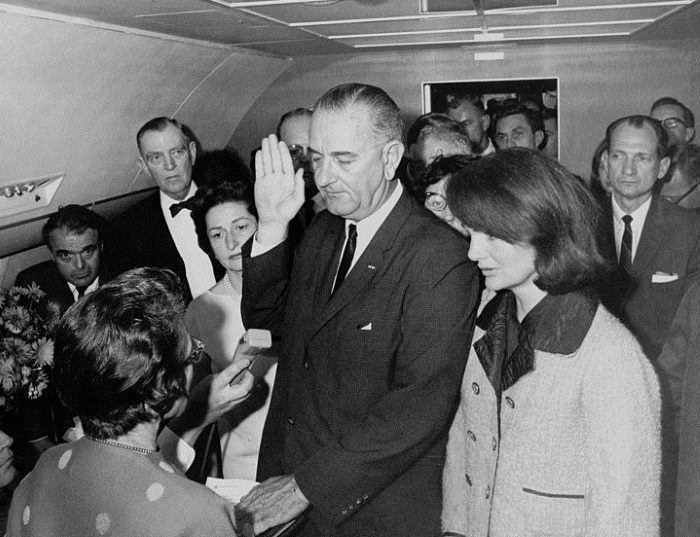
Police inspecting the TSBD found that boxes had been moved around the northeast corner of the sixth floor to provide concealment, as well as a "rifle rest" behind the window. Three empty cartridges were found in the "sniper's nest", along with an improvised paper bag. A Carcano rifle was found shoved between boxes near the stairwell.
* In the meantime, the presidential limousine arrived at Parkland Hospital, with the wounded passengers taken into Emergency. The doctors working on JFK noticed the wound in his throat immediately, but it took them about 15 minutes to notice the head wound in his thick hair. It was obviously fatal. He was given last rites by a priest and announced dead at 1:00 PM. Much has been made of the observations of the Parkland doctors of JFK's wounds, but they were frantically trying to save his life and didn't give JFK any detail inspection; they never even turned Kennedy over to examine his back. JFK's body was taken off their hands. Connally's injuries were serious, but he survived.
Kennedy's death was publicly announced at 1:33 PM. A little after 2:00 PM, JFK's body was taken in a casket to Love Field, where it was loaded into the rear of the presidential jetliner AIR FORCE ONE; a row of seats had been removed to accommodate it. At 2:38 PM, just before the departure of AIR FORCE ONE, Lyndon Johnson took the oath of office and became President of the United States.
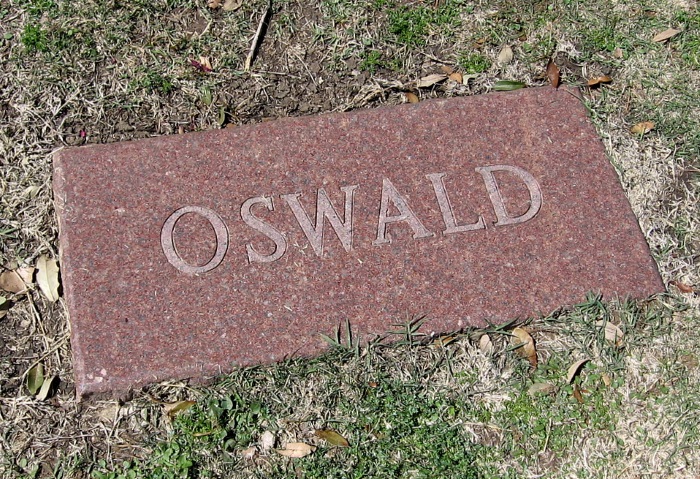
AIR FORCE ONE landed at Andrews Air Force Base near Washington DC and JFK's body was taken to Bethesda Naval Hospital in Maryland, where a team of doctors performed an autopsy that lasted until about 11:00 PM. JFK's body was then embalmed and prepared for funeral during the dark hours of the morning. Kennedy was laid to rest in Arlington National Cemetery on Monday, 25 November. The funeral was attended by representatives of 90 nations and watched on television by a collectively stunned nation.
* Oswald was not among the viewers. He had been arraigned for shooting the president and Tippit, but under repeated interrogations Oswald denied everything, telling obvious lies: "I never owned a rifle myself ... I was never in Mexico City." He claimed he was "just a patsy", that the police were trying to pin the assassination on him because he was a Red. He was put through lineups where witnesses identified him as the man who had shot Tippit.
On the morning of Sunday, 24 November 1963, Oswald was to be transferred from City Hall to the Dallas county jail; the police had been phoned death threats against him and wanted to move him to a more secure facility. However, as officers were transferring him to an armored van in the basement of City Hall at 11:21 AM, Dallas nightclub owner Jack Ruby dashed up to Oswald, shoved a revolver into his abdomen, and put one bullet into him. The shooting was caught live on national television. Oswald was rushed to Parkland Memorial Hospital, where he was pronounced dead at 1:07 PM.
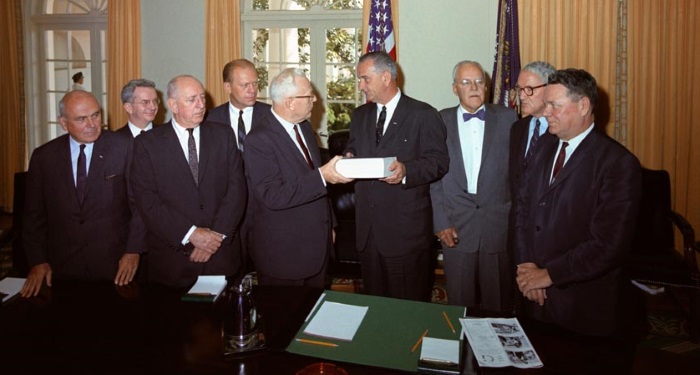
Robert Oswald took care of the burial of Lee, in the face of considerable difficulties -- one minister refusing to officiate, saying: "Your brother was a sinner." The body was exhumed in 1981, in consequence of far-fetched rumors that it wasn't really Oswald who had been buried. An autopsy confirmed his identity, and Oswald since has rested in peace.
BACK_TO_TOP* In the wake of the assassination of JFK, there was a strong public outcry for an investigation of the crime, and so on 29 November 1963 President Johnson set up a special commission, headed by Supreme Court Chief Justice Earl Warren, to investigate the assassination. After eight months of investigation the "Warren Commission" presented its final report, 888 pages long, to LBJ on 24 September 1964. The commission had examined the testimony or depositions of 552 witnesses and considered 3,100 items of evidence, with assistance from the FBI, the Secret Service, the CIA, the Army, and other government organizations.
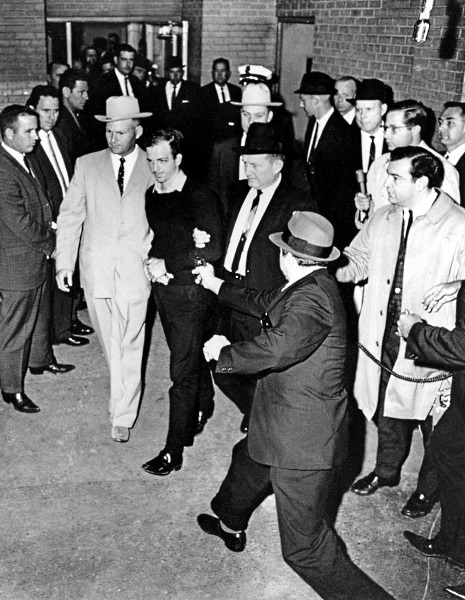
The Warren Commission concluded that three shots were fired at the presidential motorcade -- one shot missing, another striking the president through the throat and then smashing through Connally's side, the last hitting JFK in the head. The commissioners thought it possible that the order of the shots could have been different, but alternative sequences were implausible. The autopsy of JFK showed he was hit from above and behind. The evidence accumulated by the Warren Commission that Oswald was the shooter was overwhelming:
Oswald was entirely uncooperative with the police, refusing to say why he had been carrying a pistol, and telling obvious lies. In his mug shots, he was all but smirking at the camera. Earl Warren, an experienced prosecutor, once commented: "You can't prove conclusively that Oswald did it, but you can get close enough to convict him in a two-day trial." Justice does not, cannot, work with mathematical precision.
BACK_TO_TOP* From 1976 to 1978, the US House of Representatives also conducted an investigation of the assassination of JFK, as well as that of the 1968 murder of civil rights activist Dr. Martin Luther King JR. The "House Select Committee On Assassinations (HSCA)" published its report in 1979.
The HSCA report generally confirmed the work of the Warren Commission -- concluding that Oswald fired three shots at the presidential motorcade -- one shot missing, another striking the president through the throat and then smashing through Connally's side, the last hitting JFK in the head. Although the HSCA was critical, some believe excessively so, of the autopsy of the president performed in 1963, the report concluded that the autopsy was in all major respects correct, that he had been hit from above and behind. HSCA analysis showed the possible directions of the shots were in a "cone" centered on the northeast window on the sixth floor of the TSBD.
The HSCA also judged that the Warren Commission had failed to adequately investigate leads that suggested a conspiracy, and so energetically dug into such leads as could be found. Nothing turned up; HSCA investigators who went to Mexico City to follow up the many rumors that arose from Oswald's visit there found "not a thing." The report concluded there was no cause to believe any US government organization was involved in the assassination, and there was no evidence that could specifically identify any other groups as involved in the assassination.
There seemed to be a certain reluctance among the HSCA members to accept the findings of their own investigation, the final report saying the possibility of a conspiracy couldn't be ruled out -- like saying they didn't have any evidence alien UFOs had visited the Earth, but couldn't say they hadn't. That reluctance then went over the bounds into desperation when, at the last moment of the investigation, researchers from the firm of Bolt, Beranek, & Newman came forward to declare that a Dallas police audio recording made on 22 November 1963 indicated a fourth shot, suggesting a second shooter, possibly firing from a "grassy knoll" south of the TSBD along Elm Street. The HSCA then announced there was, in fact, evidence of a conspiracy to kill JFK.
The "acoustic evidence" was, on the face of it, of enormous significance, since it was the only evidence of a conspiracy in the murder of JFK that was ever uncovered by an official investigation. Several members of the committee thought the acoustic evidence was much too slender a thread on which to hang so much. There actually wasn't an obviously identifiable sound of a fourth shot on the recording, which was noisy and low quality to begin with.
The acoustic evidence began to fall apart from the moment it was announced to the world. According to the scenario outlined by the HSCA, the recording was supposedly picked up from the radio on the motorcycle of Dallas Police Officer Hollis "H.B." McLain, his mike supposedly being stuck in the ON position. When McLain learned of this, he said it was nonsense:
McLain was particularly annoyed because he had gone to Washington DC to testify to the HSCA; he could have told the staff they were off base had he known what they were doing -- but they assured him he didn't need to hear the tape, restricting their questions to him to those convenient to their agenda. Along with the problems revealed by McLain, it was then pointed out that the voice chatter on the recording indicated that the fourth shot would have taken place about a minute after the third shot, by which time the presidential limousine was long gone.
As damning as these facts were to the acoustic evidence -- and nobody could credibly dispute them -- in 1982, the Department of Justice still set up a panel from the US National Academy of Sciences (NAS) to examine the issue. The "Committee On Ballistic Acoustics (CBA)" included a dozen scientists, headed by Nobel Prize-winning physicist Norman Ramsey, and including Luis Alvarez, another Nobel-prize winning physicist; the committee flatly dismissed the acoustic evidence. The DOJ never took Congressional investigations very seriously, seeing them as half-baked and likely to interfere with their own investigations.
Later attempts to revive the acoustic evidence went nowhere. It wasn't based on well-established forensic techniques for which there was a substantial body of experience, or which had been reviewed by a skeptical eye; once exposed to review, it collapsed like a house of cards. The bottom line of the two government investigations of the JFK assassination was that:
Oswald was too unreliable and unstable to be regarded as a useful agent; and on the other side of that coin he was nobody's "patsy", being resentful of authority, all authority, and much more inclined to manipulate others than be manipulated himself. In addition, if Oswald had been in the hire of a ruthless and efficient conspiracy, there is no way he would have been left to be arrested and questioned for almost two days; the plan would have ensured his getaway, and then his permanent disappearance.
BACK_TO_TOP